Des Voeux Road West in Sheung Wan, Hong Kong Island, is where most of the dried seafood shops are. It is in fact known as the Dried Seafood Street. We found ourselves walking down this street every day on a past trip to Hong Kong, whether we needed to catch a tram, train or bus somewhere as our hotel was nearby.
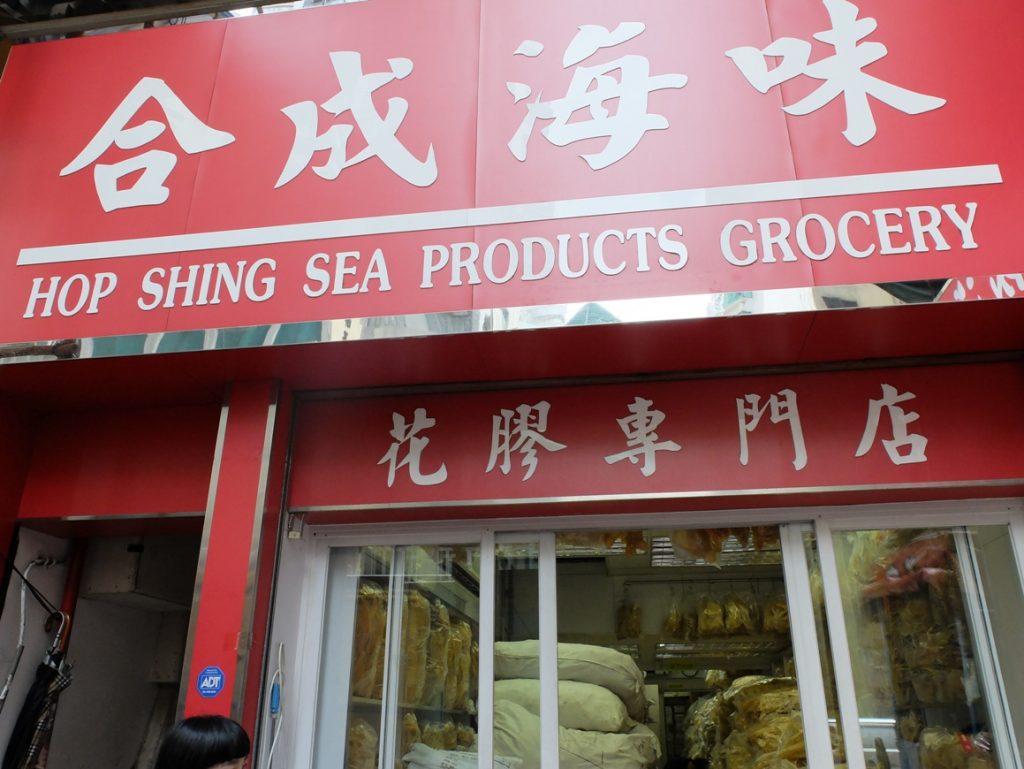
The well-known seafood shop in Hong Kong
We did stop by for some serious shopping for dried seafood, at Hop Shing Sea Products Grocery that was packed to the rafters with bags of dried fish maw. It’s the biggest supplier of fish maw in Hong Kong. We wouldn’t have ventured into this shop on our own, but we had great company and expert advice from Jeannette Han, owner of Elegant Inn, a fine-dining Hong Kong restaurant in Kuala Lumpur.

Dried fish maw stacked to the rafters
It’s an eye-opening experience, choosing the right fish maw to buy, for a friend who had a stretchable budget, and for myself, who didn’t. The fish maw pieces I bought for myself were smaller, but still of a good quality, and the friendly shop guy packed it and sealed the bag for me, with a handful of star anise inside. These were to prevent worms from attacking the fish maw.

Superior Fish Maw, the dried one and the one ready for cooking
“The value of fish maw has gone up in the absence of shark’s fin for soup,” said Jeannette. Otherwise “pau sum chi toh” – abalone, sea cucumber, shark’s fin and fish maw — the four “kings” of Chinese cuisine would be served at any banquet or celebration.
Jeannette makes regular visits to Hong Kong to get her supply of dried seafood – abalone, fish maw, dried scallops, har kon or dried shrimps, dried conch, sea cucumber, dried oysters – as well as other items that complement a Chinese meal, such as Chinese tea, and other dried herbs and foodstuff.
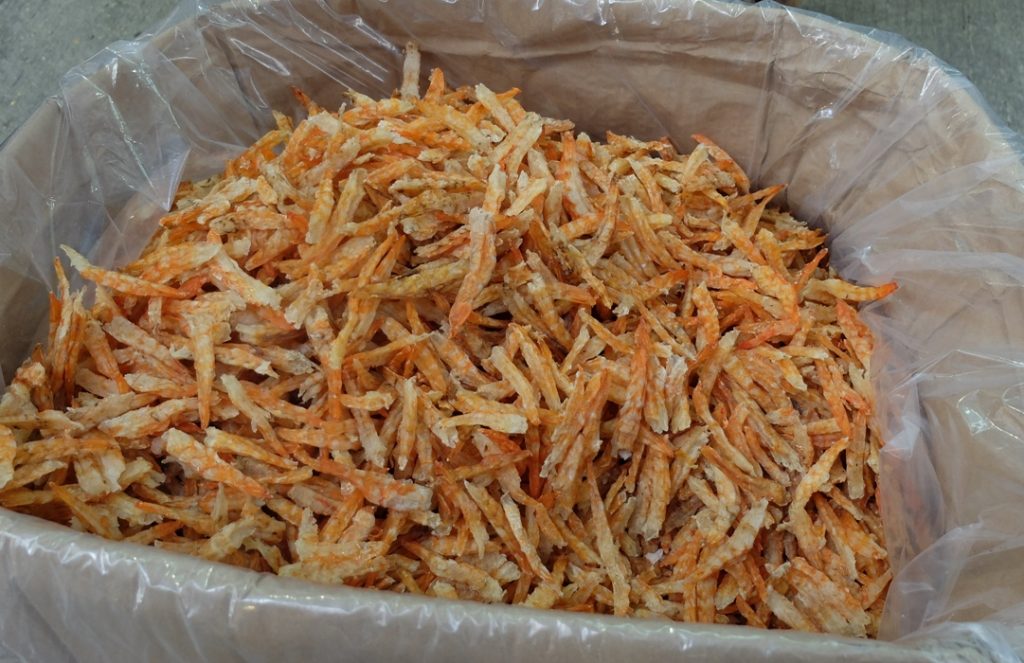
Har Kon or whole dried prawns
One variety of dried seafood that I bought was har kon or dried prawns. They are whole big prawns that have been dried, unlike the har mei, small dried shrimps which we can find in Malaysia. Har mei has a different aroma and taste when fried till crispy and are somewhat hard in texture, while har kon is fleshy, sweet and has a light, crispy bite or soong chooi after frying. It’s such a versatile ingredient.
The har kon was bought at a stall in a lane between two blocks of shophouses in Des Voeux Road where we also encountered salted fish of several varieties and sizes, and dried anchovies. The shops were also overflowing with dried scallops, dried abalone, dried sea cucumber and dried oysters.
In between the dried seafood shops are also those that sell waxed meats, pork and liver sausages and blocks of ham for soup, among other preserved ingredients. We bought some ham here.
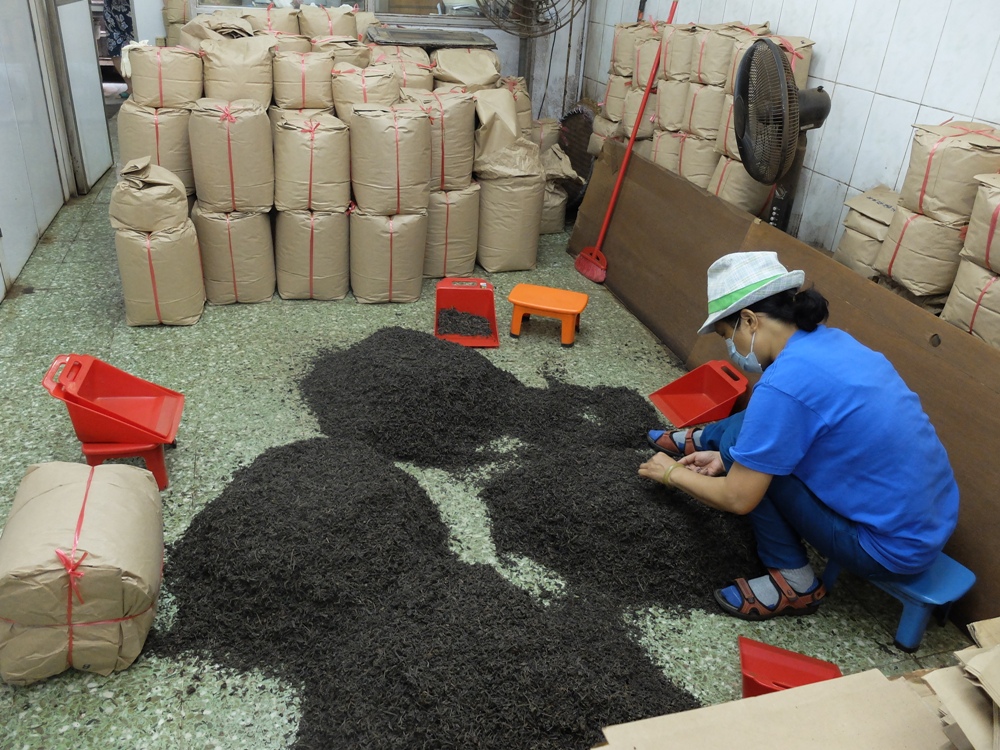
At the Chinese tea shop
I loved the smell of Chinese tea at a tea shop where Jeannette stopped and recommended the fragrant Shou Mei which she serves in her restaurant, I bought some and got them packed and sealed in small bags.
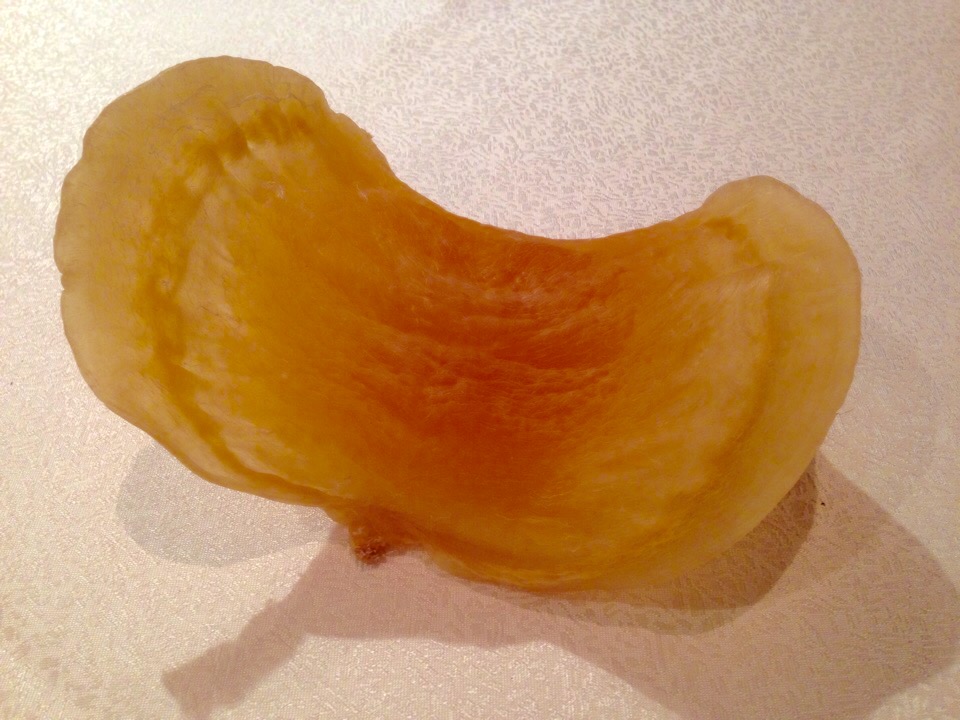
Supreme Fish Maw 鳘公胶
Fish maw or Fa Kau
This is the swim bladder of the fish. The male one is more solid and does not melt easily when cooked while the female one gets soft easily. Of course male fish maw is more expensive and much sought after. There’s lots of collagen in fish maw, and there’s more of this in the male one.
The best fish maw, according to Jeannette, is the Mun Yu Toh, from Pakistan. Fish maw is for cooking in soups, or for braising. “Most restaurants are using fish maw from New Zealand,” said Jeannette. Most fish maw is from farmed fish. “It should look golden when you buy it. As it ages, it becomes darker. Don’t buy the bleached ones. While clarity is important in fish maw; thickness and size are vital as well. The bigger and thicker, the better.”
Special on the Elegant Inn menu for Chinese New Year is Double-boiled Fish Maw with Premium Wild Porcini, Conch and Village Chicken Soup. There is also the Double-boiled Cordyceps Flower, US Topshell and Chicken with Fish Maw Soup.
“Fried fish maw or yue piu is more popular here. They are ready to use – just blanch and fry. They are cottony in texture and are ready to soak in the flavours of other ingredients. You can do a Har Mei Po, with the yue piu braised with abalone sauce, prawns, cuttlefish and sea asparagus.”
Preparation
Wash the fish maw. Bring water to boil in a pot, add ginger and spring onion. Put the fish maw inside, turn off the fire and leave it overnight. It should feel succulent and bouncy when you take it out.
“You can keep it in a bowl of water and leave in the fridge, to be used any time, but the water should be changed regularly,” said Jeannette. “You can also freeze it and it will last for several months.”
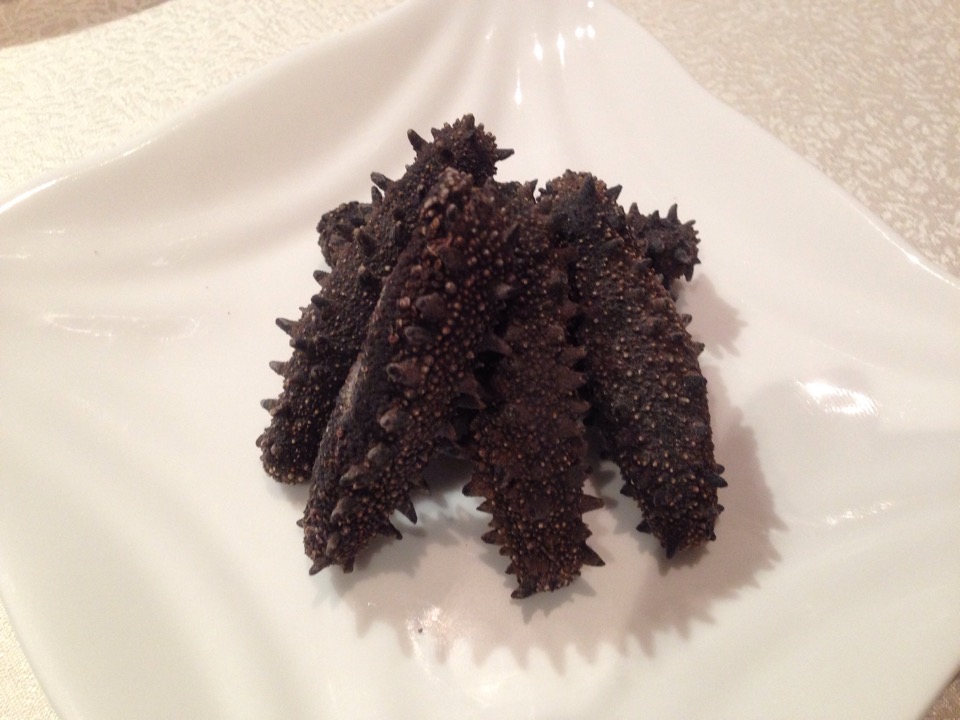
Japanese Sea Cucumber 日本刺参
Sea cucumber or hoi sum
Sea cucumber comes from China, Australia, Indonesia, Japan, the Solomon Islands and Mexico. There are three main grades – Guang Sai, Guang Tong and Hokkaido. The last is the best. Japanese sea cucumbers are smaller, with spikes or thorns, but they are five to eight times bigger after soaking. They are very expensive unlike the cheaper China ones which have a lower yield after soaking.

Stuffed Japanese Sea Cucumber with Abalone Sauce at Elegant Inn
Then there is the fat and thick “Chee Por Sum” (pig’s sow sea cucumber) which comes from Solomon Islands. “You should go to a dependable source when buying sea cucumber,” said Jeannette.
Sea cucumber can be braised with minced pork, water chestnuts and dried shrimps, in abalone sauce or oyster sauce. Serve it paired with a piece of braised fish maw, Chinese mushrooms and broccoli.
It can also be added to soup. Sea cucumber, abalone and fish maw are prized ingredients in Fatt Thieu Cheong or Double-boiled Buddha Jumps Over the Wall, as it is called at Elegant Inn.

Chu Po Sea Cucumber猪婆参
Preparation
Preparing dried sea cucumber for cooking is laborious work. It has to be soaked and boiled a few times in water with salt before it’s ready for cooking. However, some sea cucumbers don’t need boiling; just check on its readiness.”

Braised Whole XL Foot Long Stuffed Sea Cucumber with Japanese Dried Oyster & Fatt Choy
For the Chee Por Sum, the dried ones have to be put over a fire and the ash scraped off the skin. “Wash till it’s clean and soak in cold water for two days. Then it has to be boiled in hot water a few times. The sea cucumber is then soaked in cold water before it’s ready to be used.”
Dried conch
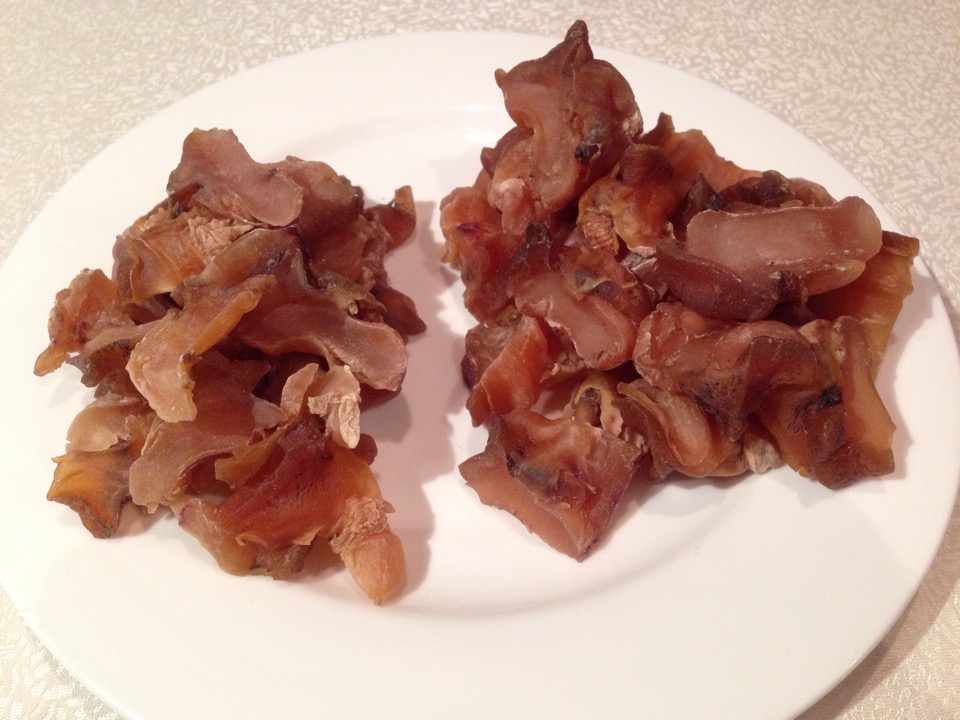
Dried Conch干螺头
This has a mildly sweet clam-like flavour and and it’s great for boiling soups with. It’s a quarter of the price of Japanese dried scallops. There are two main types of conch — hoong lor and pak lor (red and white conch). The red ones are more expensive, but they have to be naturally red. Don’t fall for the promise of sweetness, advises Jeannette, as they could have been soaked in sugar or MSG.
It’s also not normal to see a few layers of shiny glaze in the conch. If you find deep white spots and can press them in, the conch is rotting already. Dried conch is usually from South Africa. They are of different sizes, but the bigger they are, the better.
Dried scallops
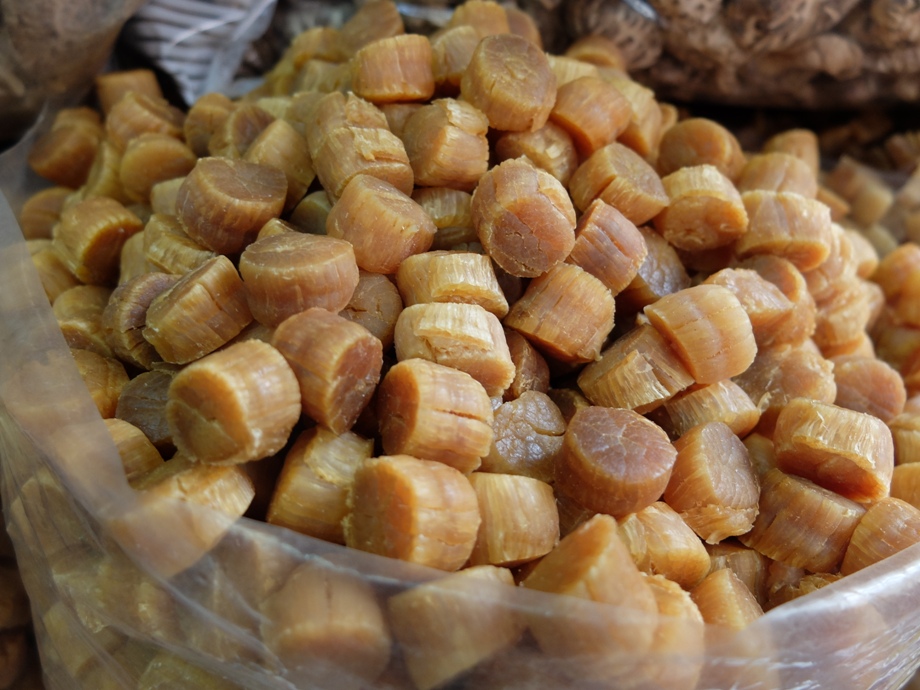
Dried scallops
There are two main sources of scallops – Japan and China. The ones from China are smaller and paler, and have a shiny glaze.
The Japanese scallops are defined by sizes and grades. Grade 1 to 3 refers to how compact the scallops are. The more cracks there are, the lower the grade. The Japanese ones are naturally better. “They have a natural marine flavour and are tastier,” said Jeannette. But she conceded the Chinese scallops have improved a lot, with the help of Japanese expertise.
You can keep your scallops for a long time in your refrigerator. The longer they are kept, the better they are, with an aged, darker colour. They are better than the pale dried scallops.

A dried seafood shop in one of the side alleys near our seafood shop
Har kon or dried prawns
There is the question of quality when buying har kon. They are dried prawns and are different from dried shrimps or har mei which we get back in Malaysia. They differ in size, texture and taste. Two types of prawns are used for drying — Ma Har and Hoong Har – the first variety being of better quality. In Thailand, tiger prawns are used, and they are consistent in size and colour. They are not as sweet as the Hong Kong ones.
Hong Kong and China are the biggest suppliers, but Hong Kong has the edge where quality is concerned, according to Jeannette. The har kon we bought in Hong Kong were big and naturally sweet, with a nice, prawny aroma.
Preparation
Har kon is a really versatile ingredient. “They can be just washed and eaten as a snack,” said Jeannette. There is no need to soak them, unlike har mei.
Har kon can also be steamed with soya sauce, ginger and a little sesame oil and eaten with rice. In Hong Kong, we had whole pieces of har kon deep fried and laid on top of fried kai lan and it was totally scrumptious. There are crunchy har kon pieces in the delicious Dancing Fried Rice at Elegant Inn.
Dried oysters
Buy dried oysters from the freezer in Hong Kong, or anywhere else for that matter, advises Jeannette. “In Malaysia, because of the heat and humidity, the dried oysters always look oily in the shops. But some suppliers sell them straight from the freezer to retain their freshness.”
There are the Korean and Japanese dried oysters, the former being cheaper but the Japanese ones are more flavourful and succulent. Dried oysters also come from China, usually huge ones threaded on a bamboo. November and December is when the kam hoe or golden oysters from China are sold in Hong Kong.

Chinese sausages, waxed meats galore at one of the shops in Hong Kong
All the dried seafood from Hong Kong can be enjoyed at Elegant Inn HK Cuisine at 2nd floor, Menara Hap Seng, Jalan P. Ramlee, Kuala Lumpur, tel +603 2070 9399. Go to its Facebook to view its Chinese New Year set menus.
For more information on the dried seafood street, visit http://www.discoverhongkong.com/us/shop/where-to-shop/street-markets-and-shopping-streets/dried-seadfood-street-and-tonic-food-street.jsp


1 Comment